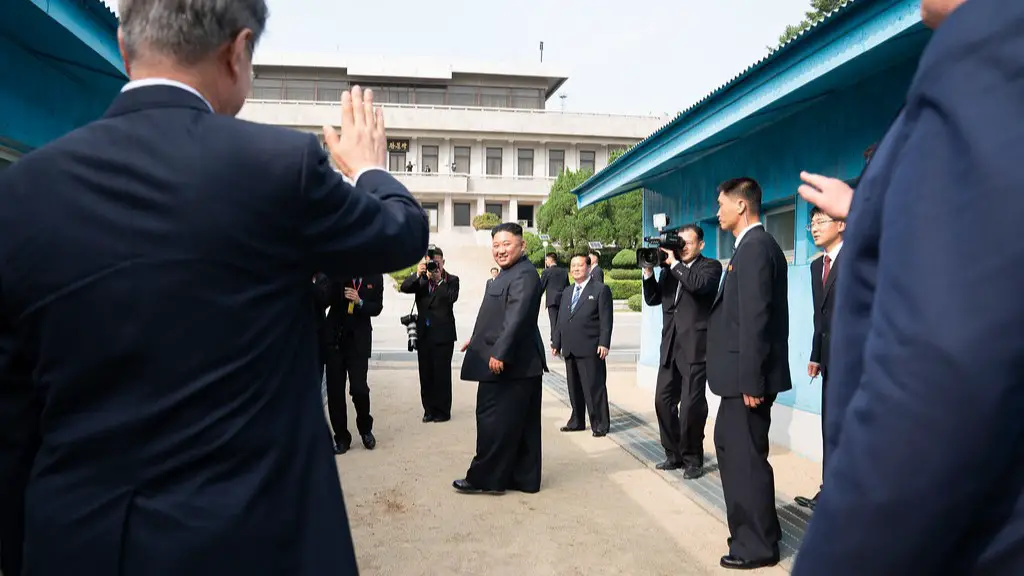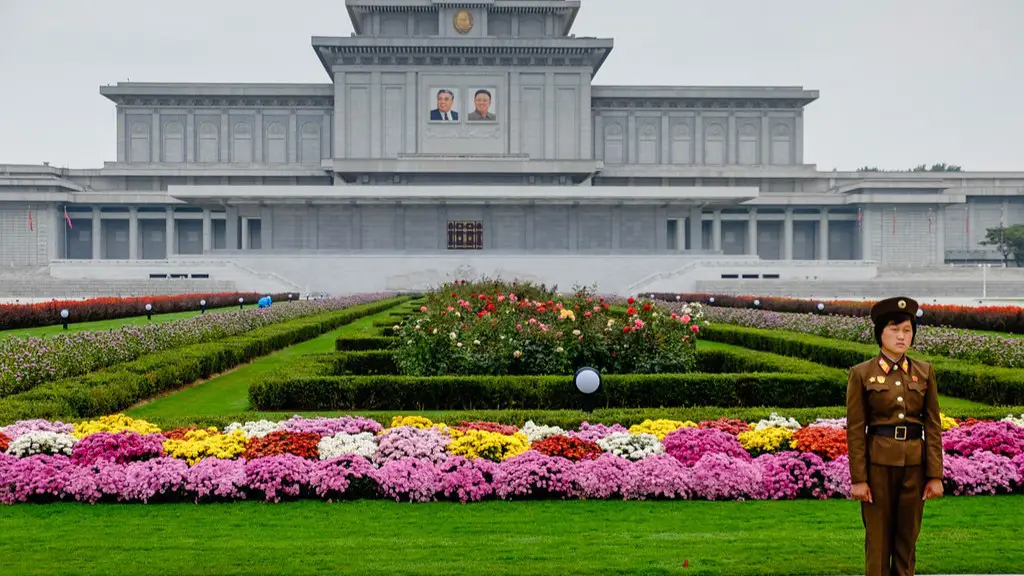Overview
The Korean conflict is one of the oldest and most complex unsolved international disputes. South and North Korea have been divided since 1945 after the defeat of Japan in World War II, and the two nations have been in a constant state of tension, sporadically escalating into limited armed conflicts. The Korean conflict, generally speaking, is rooted in issues of security, succession and sovereignty, as well as Cold War rivalries and alliances. This article seeks to offer an overview of the major issues at the heart of this ongoing conflict and why the two Koreas continue to face off.
Historical Context
Prior to the outbreak of the Korean war in the 1950s, Korea had a long, complex history. In 1876, the Korean Peninsula was annexed by the Japanese Empire and became a part of the latter’s territories until 1945 when it regained its independence. After World War II and Japanese defeat, the peninsula was divided into two factions along the 38th parallel, with the U.S. taking control of the south and the Soviet Union of the north. This division, not accepted by the Koreans, represented a growing tension between the Soviets and the Americans during the Cold War, as both attempted to strengthen their respective spheres of influence.
Within a short period of time, the two Koreas developed very different socioeconomic and political systems. South Korea embraced emerging democracies, while North Korea was transformed into a Stalinist state. In 1950, a war broke out as North Korea invaded the south, and both sides sought to reunify the peninsula under their own control and ideology. Although the war was concluded three years later, the two Koreas remain divided by a heavily reinforced demilitarized zone, and peace treaties were never signed.
Security Threats
Safety and security are among the primary concerns that define the relationship between the two ideologies. South Korea, backed by the United States, maintains world-class military forces and defense systems, which threaten North Korea and vice versa. Each side has modernized their armies as well as their nuclear arsenals, despite the fact that North Korea officially withdrew from the Nuclear Non-Proliferation Treaty in 2003. This environment of constant distrust and fear is a major factor driving the irreconcilable differences between the two states.
Objectively speaking, for North Korea the threat is about sovereignty and regime security, as Kim Jong-un values above all else his nation’s ability to negotiate from a position of strength. On the other hand, South Korea feels that it is under threat because Kim’s aggressive posturing creates a precarious situation that could lead to a full-scale nuclear conflict. As a result, South Korea is taking strong measures to make sure it is ready for any potential North Korean aggression.
Economic Woes
From an economic perspective, the two Koreas are worlds apart. North Korea follows a Stalinist command economy while South Korea has a much more liberal one. North Korea is struggling to feed its population and its highly oppressive regime has tripled the number of North Koreans living in extreme poverty in ten years, according to the latest World Bank’s report. In addition, over four-fifths of industry is state-owned, making it harder for the country to engage in international trade and attract foreign investments.
On the other hand, South Korea has experienced unprecedented economic growth, highlighted by its technologically advanced society and robust labor, trade and investment policies that have led to a much higher living standard. As a result, South Korea is the 15th largest economy in the world, while the North remains one of the world’s poorest countries, with an array of problems related to human rights and the limited freedoms enjoyed by its citizens.
Inter-Korean Relations
Since the two sides remain at a stalemate in terms of peace treaties, inter-Korean relations have been tense and unpredictable, with the occasional attempt at detente. In 2018, North and South Korea signed a joint declaration, promising a wide range of peace initiatives, such as the construction of the railway cross the border and the reforestation of the heavily mined demilitarized zone.
However, any progress towards a potential unification has been met with substantial skepticism, as both authorities continue to disagree on issues such as the disarmament of nuclear weapons and the relinquishing of ideological disputes. Many experts also believe that North Korea continues to exploit the threats of military action as a political weapon to obtain economic aid from the South.
Alliances and Regional Tensions
The Korean conflict is also closely linked to regional tensions, particularly the Sino-American relationship. Both China and the United States are major allies of the two Koreas, but with different objectives. For China, a unified Korea is the best solution, as it would serve as a safer buffer zone between the United States and China, countering many of the American moves in Asia.
On the other hand, the United States is more concerned with maintaining stability in the Korean Peninsula as it is a valuable ally, while it is more wary of China’s increased dominating presence in the region. In addition, the United States is also against any Korean unification, as it would threaten its own position in the region, and would most likely make way for a Chinese-backed unified Korea. As a result, the American approach tends to be focused on maintaining the status quo, as a unified Korea would diminish its influence.
What Are Modern Solutions?
Given the complexity of the Korean conflict, it is difficult to envision any potential solutions. The signing of a peace treaty still appears unrealistic, while the reduction of military threats is often overshadowed by the occasional aggressive provocations of North Korea.
Therefore, overcoming the security stalemate and easing the economic disparities between North and South could be the best path forward. This process may require unprecedented levels of commitment to diplomacy and negotiations, as well as mutual trust, active implementation of economic initiatives and additional regional diplomatic cooperation.
What Does The Future Hold?
Although optimism abounds, the predominant view is that no significant progress can be expected overnight. Many observers believe that the bottom-up approach of developing grassroot initiatives such as cross-border trade, political participation and reunification of families should be at the forefront of any resolution process.
Ultimately, any long-term solution will have to be found with the active participation of all entities involved, including both Koreas and their respective allies. The resolution of the Korean conflict will require an unprecedented level of cooperation and a commitment to setting aside long-standing historical animosities and turning the page to a brighter and brighter future for the people of both Koreas.
Implications for International Stability
The stability of the Korean Peninsula is of global importance and a reliable resolution of the conflict would go a long way in contributing to regional and international peace. The United Nations should play a more active role in the peace process, while the great powers should openly promote non-interventionist measures and dialogue between the two Koreas.
In addition, South and North Korea should build on the 2018 agreement by resuming the inter-Korean dialogue, engaging more directly in political and economic exchanges and using the opportunity of a unified Korea to amplify a positive global example, displaying the Korean culture and commitment to lasting peace.
US-China International Relations
The Korean conflict is one of many geopolitical flashpoints, such as the South China Sea and the Middle East, that contribute to the rift between the United States and China. For the United States, these flashpoints are part of its strategy to contain China’s expanding influence. On the other hand, China views the United States’ policy as an attempt to export its values and stifle its rise on the global stage.
The United States is also concerned about China’s close ties with North Korea, as it believes China is undermining American efforts in the Korean Peninsula. As a result, the two powers will likely remain at odds over the Korean conflict, and their respective approach to the conflict will have significant implications for the stability of the entire region.
Prospects of a Unified Korea
Although peaceful and sustainable unification of the Korean is not something that is being pursued actively by either Korea, a unified Korea, if properly managed, could bring tremendous economic and social benefits to the two nations. In this respect, the two Koreas should set aside their differences and understand the positive, transformative potential of a unified Korean Peninsula.
Other agendas, such as economic integration and cooperative development, should become part of a much broader strategy that includes both cooperation and trustbuilding initiatives. Making use of the diplomatic and economic resources already available and developing long-term transformative plans, the two Koreas could make a real difference in finding a viable and lasting resolution to the Korean conflict.


